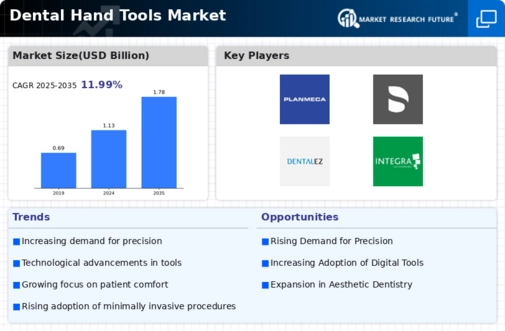Market Analysis
In-depth Analysis of Dental Hand Tools Market Industry Landscape
The ability to enhance precision and ergonomics during dental procedures coupled with emerging needs among dental professionals has been quite dynamic within the Dental Hand Tools' market space, leading to some trends registered therein over time. A primary driver behind dynamics witnessed within this market is technological innovation taking place. It should be noted that the escalating prevalence rates of dental diseases, as well as rising awareness of oral health, are some of the key drivers behind growth and dynamics in the Dental Hand Tools market. The global population is increasingly grappling with a growing burden of dental problems ranging from tooth decay to gum infections, hence leading to a demand for accurate and dependable manual tools in dental clinics. That shift also leads us to digital dentistry or computerized dentistry, where technology such as laser wands, intraoral cameras, CAD/CAM, and digital radiography are involved. Dental Hand Tools that are specifically made for minimally invasive procedures become necessary because minimal intervention means conservative. Another thing that influences the dynamics of this industry is regulatory factors. There are stringent regulations meant to guarantee the safety, efficacy, and quality of any dental instrument. Additionally, economic considerations affect market behaviors within the Dental Hand Tools sector. Therefore, affordability and cost-effectiveness determine how dentists, as well as hospitals, can adopt these instruments. Manufacturers should provide ranges that will suit different cost aspects while maintaining quality and efficiency standards. Furthermore, bulk purchase trends by many consumers or preference for bundled sets may also influence overall dynamics within this sector, thereby causing changes in its performance over time. The dynamics of the Dental Hand Tools industry are driven by competition among key players. Companies differentiate their products based on attributes such as durability, precision, and compatibility with evolving dental procedures. Dental marketing often recommends promoting ergonomic advantages and advanced features of Dental Hand Tools in order to attract dental professionals seeking enhanced efficiency and patient outcomes. The ongoing COVID-19 pandemic has affected the trade of Dental Hand Tools by spotlighting infection control and safety in dentistry. The increased awareness of the preventive measures against infection and adoption of stringent hygienic protocols have led to modifications of design and materials used in making dental hand tools. It is projected that focus on safety and infection control will continue to be a major force influencing market dynamics during the post-pandemic period.







Leave a Comment